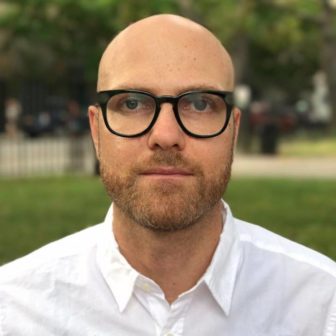(Humans of Restorative Justice stories are written and edited by David Levine based on interviews with real-world practitioners.)
Walking back into my middle school classroom after being out the previous day at a training, I first noticed that the colorful plastic chairs were not stacked neatly on desks as they usually are. I could also see some papers scattered on the floor; usually my students are great about following the clean-up routine.
It all made sense when I saw the note on my desk, handwritten from the substitute, and it was not good. I almost couldn’t believe the long list of negative comments and anecdotes she had left about what I always considered a well-behaved group of students. I guess the real test is how students behave when their regular teacher is away.

David Levine
I made sure to find one or two students from the class, the ones I knew to be upfront and honest, and I asked them what exactly had happened. It turns out the note was pretty accurate: Most of them were not listening to the sub, were getting out of chairs and making a mess, and most concerning, they had begun to make fun of the sub for speaking with a heavy accent. I was deeply saddened and knew that this needed to be addressed.
This was my first year teaching in the Pacific Northwest, and I knew that they did some things, including discipline, a bit different from where I had previously taught in Florida. I was first introduced to the idea of restorative justice at some of our staff meetings.
I was unfamiliar with it and, to be frank, skeptical. The idea of it, at first, seemed like an excuse for students to get out of any consequences for their actions. And the concept of sitting around in a circle and sharing personal details seemed a bit awkward and cheesy.
But honestly, I started to really enjoy these circles; I was laughing with my co-workers, learning about them and forming bonds more quickly than I had in years at my previous school. So, after this incident with my students misbehaving, I decided to give it a try in my classroom. I invited Gabriella, the staff member who offered facilitation, to come in and address the incident.
Tears and empathy
I wasn’t sure what to expect as I sat in the same plastic chair as my students and as Gabriella took over. She explained how the circle would work and started asking questions that we all took turns responding to. I remember that one of the questions was about a time when we had personally experienced bullying. Within minutes, my students started sharing some emotional and heartfelt experiences where they had felt hurt by bullying or seen it happen.
I was amazed at how maturely the whole group was listening and how genuinely they were sharing. It was almost like they were just waiting for a chance to get these things off their chest. I shared a story from my childhood and I could see students sitting on the edge of their seat to hear.
At one point, after someone had shared a particularly heartbreaking story, almost everyone in the group was in tears. Gabriella then connected these stories to what had happened when the substitute was in our class. She asked the group to share how they think she must have felt when she was being teased for her accent, something over which she had no control.
I could almost see some of the students making empathetic connections in their young minds. Quickly they expressed how miserable that must have felt for the woman. Many of them even related it to their own stories of bullying.
I was impressed by this, but the true test of this work came the following week when again I needed to be out of the building and the same substitute returned. You can imagine my anxiousness to read the note from the sub and my elation to hear that things had gone incredibly well this time around!
I was already warming up to restorative practices, but this experience really cemented my commitment of forging deeper relationships with my students. I have the same pressure at this school as at my last one to cover content and prepare students for state exams, but I actually think investing the time in circles like this helps us to work faster as a group and with more trust and communication overall.
I think about what would have happened back in Florida. Probably some of the more disrespectful students would have been singled out for detention. They would have sat in silence after school for the same amount of time that we sat as a classroom circle with Janet. But the whole group would have missed out on this valuable experience and a rare chance to develop empathy. Probably the students who would have received detention would feel embarrassed or upset thinking about what had happened to them, rather than reflecting deeply on how their actions had affected others.
I think it’s easy to be resistant to the idea of restorative justice, but once you have been involved in it in real life, it’s hard not to become excited about its vast potential to improve our classrooms, even when we aren’t around.
This column has been updated.
David Levine has worked as an educator at public high schools in Brooklyn and Seattle, and as a restorative justice dean in the Bronx. He is currently a course facilitator at the National Center for Restorative Justice, an organization that provides training for those looking to change their relationship to conflict. Contact him at d.levine@nationalcenterforrestorativejustice.com.

Hi Robert , If I understand the question, you would like training in RJ facilitation?
I could recommend the blended 101 course from our org..
http://www.nationalcenterforrestorativejustice.com/education-3
I am happy to discuss with him personally if you want to connect us by email:)
D.levine@nationalcenterforrestorativejustice.com
As a Prison Ministry volunteer, I would like to offer this type of service to my community. Is there a training center for people who want to serve as Gabriella did?